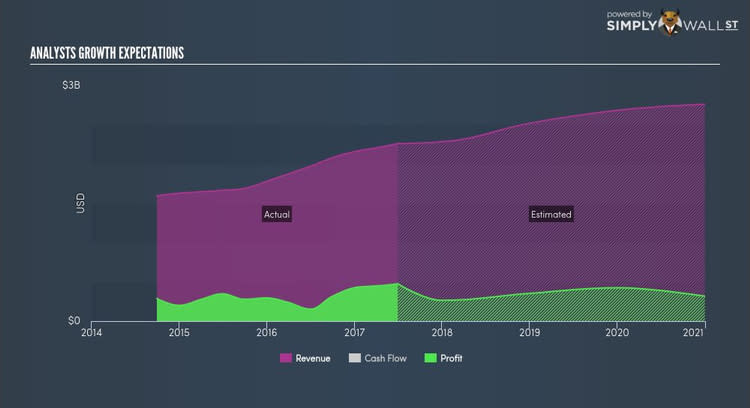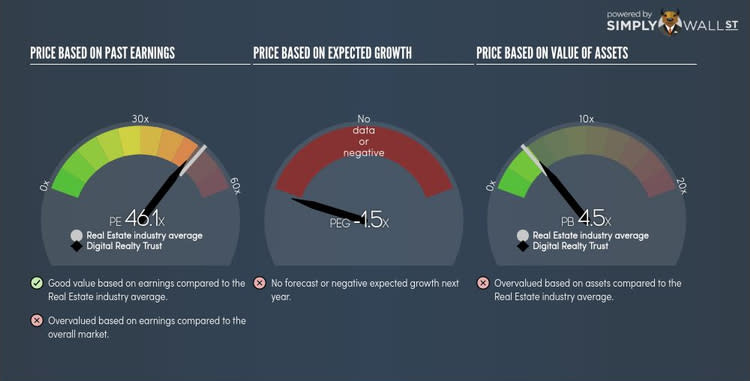What Can We Expect for Digital Realty Trust Inc (DLR) Moving Forward?

Digital Realty Trust Inc (NYSE:DLR), a USD$24.48B large-cap, is a real estate company operating in an industry which remains the single largest sector globally, and has continued to play a key role in investor portfolios as an asset class. A real estate investment trust (REIT) is a collective vehicle for investing in real estate that originated in the US and has since been taken on board globally. Real estate analysts are forecasting for the entire industry, negative growth in the upcoming year, and an overall negative growth rate in the next couple of years. Unsuprisingly, this is below the growth rate of the Australian stock market as a whole. Is the real estate industry an attractive sector-play right now? Today, I will analyse the industry outlook, and also determine whether DLR is a laggard or leader relative to its real estate sector peers. See our latest analysis for DLR
What’s the catalyst for DLR's sector growth?
Concerns surrounding rate increases and treasury yield movements have made investors dubious around investing in REIT stocks. This is because REITs tend to be dependent on debt funding. They are also considered as bond investment alternatives due to their high and stable dividend payments. In the previous year, the industry saw growth in the teens, beating the Australian market growth of 6 percent. DLR leads the pack with its impressive earnings growth of over 100 percent last year. Furthermore, analysts are expecting this trend of above-industry growth to continue, with DLR poised to deliver a triple digit growth over the next couple of years. This growth may make DLR a more expensive stock relative to its peers.
Is DLR and the sector relatively cheap?
The REIT sector's PE is currently hovering around 14 times, below the broader Australian stock market PE of 22 times. This means the industry, on average, is relatively undervalued compared to the wider market - a potential mispricing opportunity here! Though, the industry returned a similar 14 percent on equities compared to the market’s 16 percent. On the stock-level, DLR is trading at a higher PE ratio of 46 times, making it more expensive than the average REIT stock. In terms of returns, DLR generated 10 percent in the past year, which is 4 percent below the REIT sector.
What this means for you:
Are you a shareholder? DLR’s industry-beating future is a positive for shareholders, indicating they’ve backed a fast-growing horse. However, this higher growth prospect is also reflected in DLR’s high price, suggested by its higher PE ratio relative to its peers. If you’re bullish on the stock and well-diversified by industry, you may decide to hold onto DLR as part of your portfolio. However, if you’re relatively concentrated in REIT, the DLR’s high PE may signal the right time to sell.
Are you a potential investor? If DLR has been on your watchlist for a while, now may not be the best time to enter into the stock since it is trading at a higher valuation compared to other REIT companies. However, that being said, its industry-beating growth prospects may be the reason for high relative valuation. I suggest you look at DLR’s future cash flows in order to assess whether the stock is trading at a reasonable price on this basis.
For a deeper dive into Digital Realty Trust's stock, take a look at the company's latest free analysis report to find out more on its financial health and other fundamentals. Interested in other real estate stocks instead? Use our free playform to see my list of over 100 other real estate companies trading on the market.
To help readers see pass the short term volatility of the financial market, we aim to bring you a long-term focused research analysis purely driven by fundamental data. Note that our analysis does not factor in the latest price sensitive company announcements.
The author is an independent contributor and at the time of publication had no position in the stocks mentioned.


